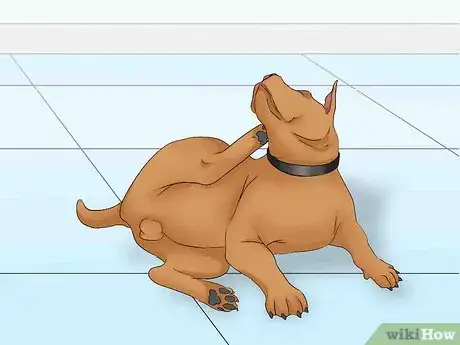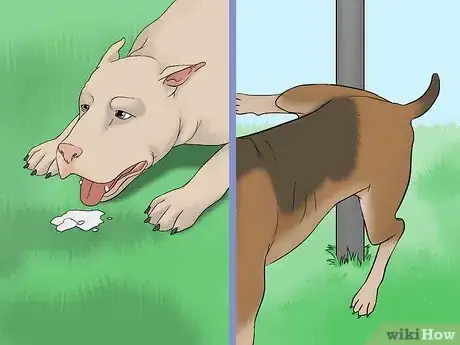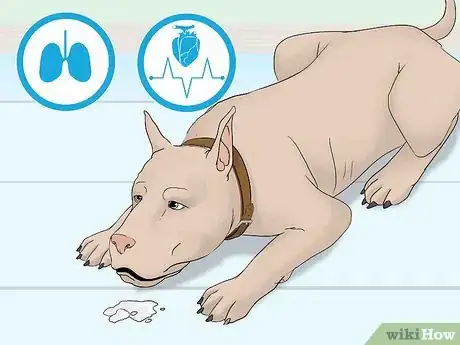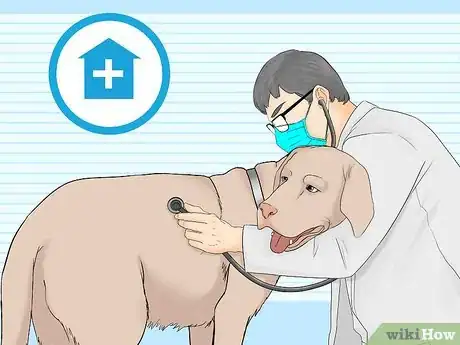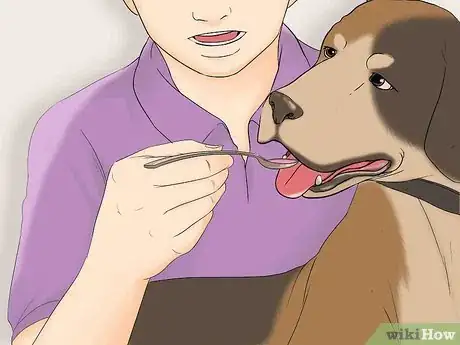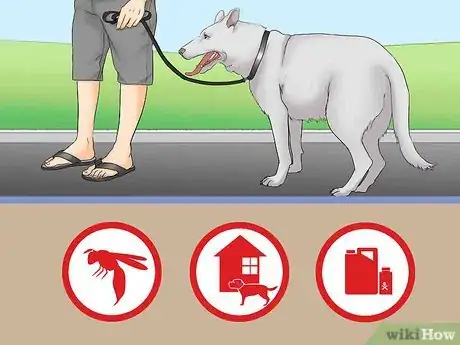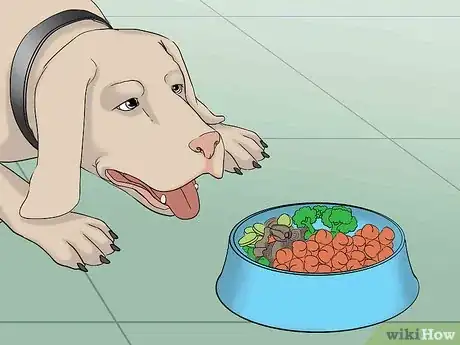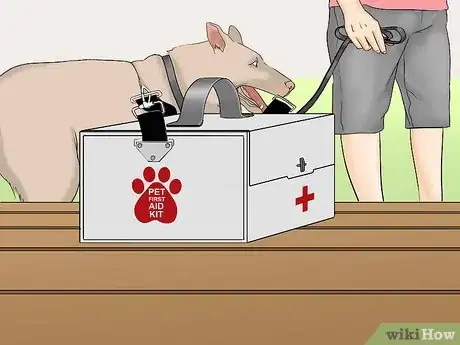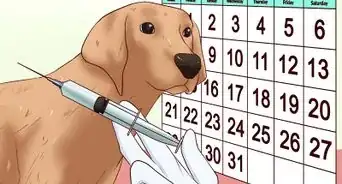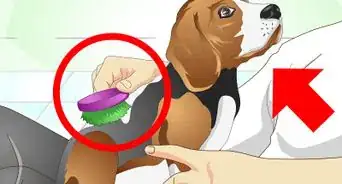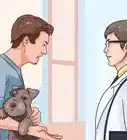This article was co-authored by Pippa Elliott, MRCVS. Dr. Elliott, BVMS, MRCVS is a veterinarian with over 30 years of experience in veterinary surgery and companion animal practice. She graduated from the University of Glasgow in 1987 with a degree in veterinary medicine and surgery. She has worked at the same animal clinic in her hometown for over 20 years.
This article has been viewed 56,850 times.
You may be surprised to learn that dogs get allergies in much the same way that humans do. However, when your dog is exposed to an allergen, whether it be from an insect bite, something it ate, or even medication, it may go into anaphylactic shock. Anaphylaxis in dogs is very serious and requires immediate medical treatment. However, by spotting the symptoms and seeking treatment for your dog as soon as possible, you can help make sure your dog has the best chance of surviving anaphylactic shock.
Steps
Spotting Symptoms of Anaphylaxis
-
1Notice if your dog starts itching right after being exposed to an allergen. Itching and scratching, along with the appearance of red spots on the skin and swelling, are the most common clinical signs of anaphylactic shock in dogs. This usually occurs within minutes of your dog coming into contact with an allergen.[1]
- The most common allergens that cause anaphylactic shock in dogs include insect bites, pollen, mold spores, dust, fleas, and environmental pollutants.
- The speed and severity of the onset of these symptoms will vary, depending on how much contact your dog has had with an allergen and through what mechanism (e.g., through the skin, through an injection, etc.).
- The most important thing to look for is the close connection between exposure to an allergen and the appearance of these symptoms. All dogs scratch themselves, but scratching soon after contact with an allergen is more likely to indicate an allergic reaction.
-
2Look out for the rapid onset of diarrhea, vomiting, or defecation. After itching and redness, these are the next most common signs of anaphylaxis. If these symptoms appear in your dog as part of an anaphylactic shock, they will also develop very quickly after exposure to an allergen.
- You may notice your dog urinating more frequently or uncontrollably, as well. Lack of bowel and bladder control is another symptom of anaphylactic shock.
Advertisement -
3Watch for signs of trouble breathing or moving in your dog. The initial symptoms of anaphylaxis (itching, vomiting, etc.) will eventually progress to shallow, rapid breathing, weakness or coldness in the limbs, and general lethargy. Your dog may also begin drooling excessively, even if there’s no food around.
- You may also notice irregularities in your dog’s heartbeat; it may have a weak pulse or an elevated heart rate.
- Some dogs may not show any early signs and may instead progress straight to collapsing.
Seeking Treatment for Your Dog
-
1Take your dog to the vet right away if you notice the symptoms of shock. Anaphylactic shock is a serious medical emergency that requires treatment as soon as possible. If possible, have someone else drive you and your dog to the vet while you take care of it. Wrap your dog in something warm like a blanket and keep its airways clear if it’s unconscious.[2]
- If you live alone, it’s a good idea to have an emergency contact that you can call and ask for help at the drop of a hat when your dog goes into anaphylactic shock.
-
2Expect your dog to be administered 1 or several medications. Once your dog is at the vet, they will remove the allergen if it is still present and then give your dog medications to bring their body back under control. Your dog may be given adrenaline, antihistamines, or hydrocortisone, depending on the nature of their anaphylaxis.[3]
- Your dog may also be administered oxygen and intravenous fluids to prevent its blood pressure from dropping too far.
- Antibiotics are often given after rescuing a dog from an episode of anaphylactic shock to prevent the chance of a secondary bacterial infection.
-
3Allow your dog to remain with the vet for 24-48 hours. Since anaphylactic shock can remain seriously dangerous even after it’s been initially treated, your dog will require close hospital monitoring for a few days after you take it to the vet. Once your dog is able to urinate without assistance, meaning it is able to retain fluids properly, it will be allowed to go home again.[4]
- This additional monitoring will focus on your dog’s pulse rate and quality, blood pressure, respiratory effort, mucous membrane color, and body temperature.
- Blood samples may also be taken to assess your dog’s liver function, as well as the condition of its other organs.
Preventing Anaphylaxis in the Future
-
1Avoid exposing your dog to allergens. Anaphylactic reactions often get worse after each episode, so it’s important to keep your dog away from whatever caused its first reaction. This might mean preventing your dog from coming into contact with stinging insects by keeping it inside as much as possible, or keeping it away from environmental pollutants and harsh chemicals.[5]
- If you’re not sure what caused your dog’s first anaphylactic reaction, the best thing to do is to keep it away from whatever environment it was in where it first went into anaphylactic shock. For instance, avoid walking your dog in the park where it first developed anaphylaxis.
-
2Change your dog’s diet if it went into shock because of a food allergen. Talk to your vet to determine if your dog is allergic to something in its dog food and to find out what food you should be feeding it. You may be required to strictly monitor the ingredients and chemicals in your dog’s food in order to prevent future anaphylactic reactions.[6]
- Your vet may also recommend that it not be given certain oral medications, if these were the cause of its anaphylaxis.
-
3Carry emergency medications for your dog if your vet recommends this. Depending on how at-risk your dog is of another anaphylactic reaction, your vet may give you medications to use in the event that your dog goes into shock again. While your dog will still require immediate medical treatment for anaphylaxis, the medications will help minimize the harmful effects of the episode.[7]
- If your dog is allergic to insect stings, ask your vet if you should carry an EpiPen for your dog. This is a small syringe containing epinephrine that can be used to partially, though not entirely, treat your dog’s allergic reaction.
Warnings
- Don't wait to seek treatment if you suspect your dog is experiencing anaphylactic shock. This type of allergic reaction is nearly always fatal when left untreated, so it’s better to be safe and take your dog to the vet even when you aren’t sure if it’s anaphylaxis or not.⧼thumbs_response⧽
References
- ↑ https://vcahospitals.com/know-your-pet/anaphylaxis-in-dogs
- ↑ https://dogtime.com/dog-health/52935-anaphylaxis-dogs-symptoms-causes-treatments
- ↑ https://dogtime.com/dog-health/52935-anaphylaxis-dogs-symptoms-causes-treatments
- ↑ https://www.petmd.com/dog/conditions/respiratory/c_multi_anaphylaxis?page=2
- ↑ https://vcahospitals.com/know-your-pet/anaphylaxis-in-dogs
- ↑ https://dogtime.com/dog-health/52935-anaphylaxis-dogs-symptoms-causes-treatments
- ↑ https://vcahospitals.com/know-your-pet/anaphylaxis-in-dogs
About This Article
To treat anaphylactic shock in a dog, watch for symptoms like sudden itching and swelling, diarrhea, vomiting, or sudden defecation. These initial symptoms will progress to shallow, rapid breathing, weakness, drooling, and lethargy. If you notice any of these symptoms, wrap your dog in a blanket and take it to a vet or animal hospital right away. The vet will likely administer antibiotics, oxygen, and intravenous fluids to treat your dog. For more advice from our Veterinary co-author, read on!
